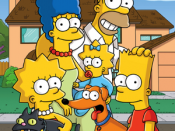The Simpsons is one of Americas most popular television shows. It ranks as the number one television program for viewers under eighteen years of age. However, the ideals that The Simpsons conveys are not always wholesome, sometimes not even in good taste. It is inevitable that The Simpsons is affecting children.
Matt Groening took up drawing to escape from his troubles in 1977. At the time, Groening was working for the L.A. Reader, a free weekly newspaper. He began working on Life in Hell, a humorous comic strip consisting of people with rabbit ears. The L.A. Reader picked up a copy of his comic strip and liked what they saw. Life in Hell gradually became a common comic strip in many free weeklies and college newspapers across the country. It even developed a cult status. (Varhola, 1) Life in Hell drew the attention of James L. Brooks, producer of works such as Taxi, The Mary Tyler Moore Show, and Terms of Endearment.
Brooks originally wanted Groening to make an animated pilot of Life in Hell. Groening chose not to do so in fear of loosing royalties from papers that printed the strip. Groening presented Brooks with an overweight, balding father, a mother with a blue beehive hairdo, and three obnoxious spiky haired children. Groening intended for them to represent the typical American family "who love each other and drive each other crazy". Groening named the characters after his own family. His parents were named Homer and Margaret and he had two younger sisters named Lisa and Maggie. Bart was an anagram for "brat". Groening chose the last name "Simpson" to sound like the typical American family name. (Varhola, 2)
Brooks decided to put the 30 or 60 second animations on between skits on The Tracy Ullman Show on the unsuccessful...



Don't Do This:
Don't submit essays twice for extra points. It's just cheap and inappropriate.
1 out of 1 people found this comment useful.